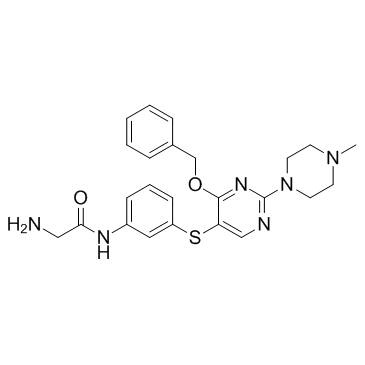1268273-90-0
| Name | HSP70-IN-1 |
|---|---|
| Synonyms |
N-(3-{[4-(Benzyloxy)-2-(4-methyl-1-piperazinyl)-5-pyrimidinyl]sulfanyl}phenyl)glycinamide
Acetamide, 2-amino-N-[3-[[2-(4-methyl-1-piperazinyl)-4-(phenylmethoxy)-5-pyrimidinyl]thio]phenyl]- |
| Description | HSP70-IN-1 is a heat shock protein (HSP) inhibitor; inhibits the growth of Kasumi-1 cells with an IC50 of 2.3 μM. |
|---|---|
| Related Catalog | |
| Target |
HSP70 Caspase-3/7:1.9 μM (IC50, MOLM13 cells) |
| In Vitro | The heat shock protein 70 (Hsp70) is a molecular chaperone which plays an important function in protein homeostasis as well as in cell signaling and survival. Hsp70 is frequently overexpressed in cancer, where the elevated expression is furthermore believed to be a cause of or to lead to resistance to chemotherapy and other treatments. HSP70-IN-1 interferes with the formation of functional Hsp70-HOP-Hsp90 machinery by its ability to dose-dependently alter the megacomplex components and to destabilize an Hsp70-Hsp90 machinery client, Raf-1. In cells, the refolding of heat-denatured luciferase by endogenous as well as transfected Hsp70 is inhibited by HSP70-IN-1. HSP70-IN-1 also results in induction of apoptosis in cancer cells. Addition of HSP70-IN-1to cancer cells dose-dependently alters the formation of the Hsp70-HOP complex, a phenomenon associated with their destabilization and reduction in half-life[1]. |
| References |
| Density | 1.3±0.1 g/cm3 |
|---|---|
| Molecular Formula | C24H28N6O2S |
| Molecular Weight | 464.583 |
| Exact Mass | 464.199432 |
| LogP | 3.27 |
| Index of Refraction | 1.686 |
| Storage condition | 2-8℃ |
